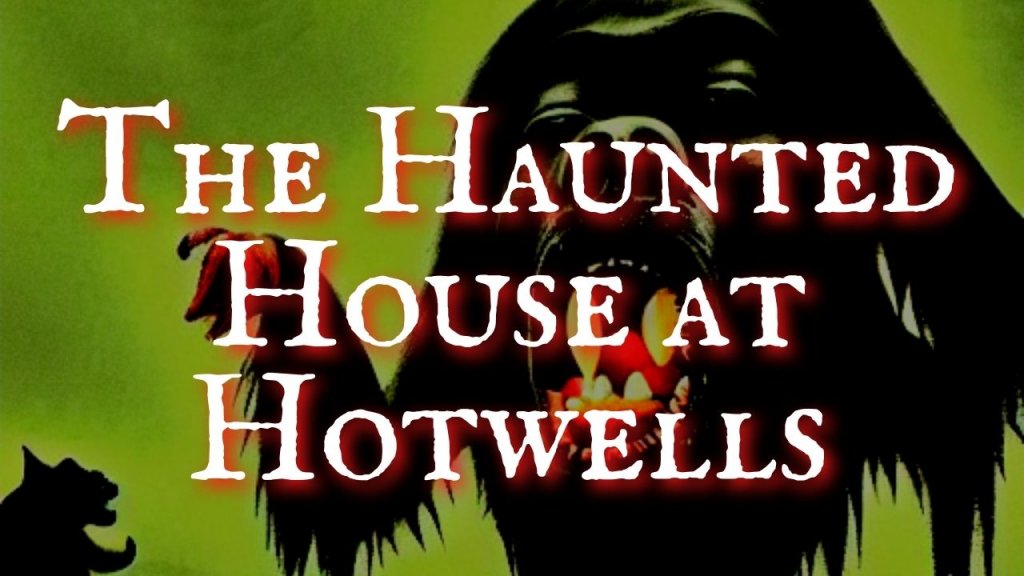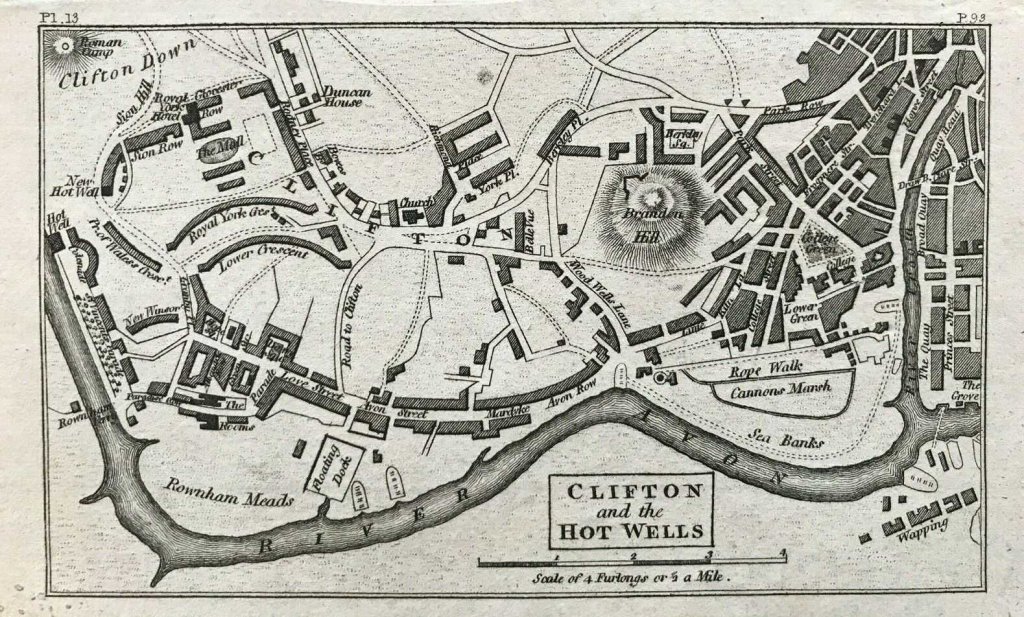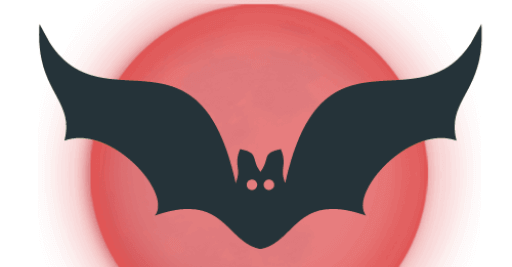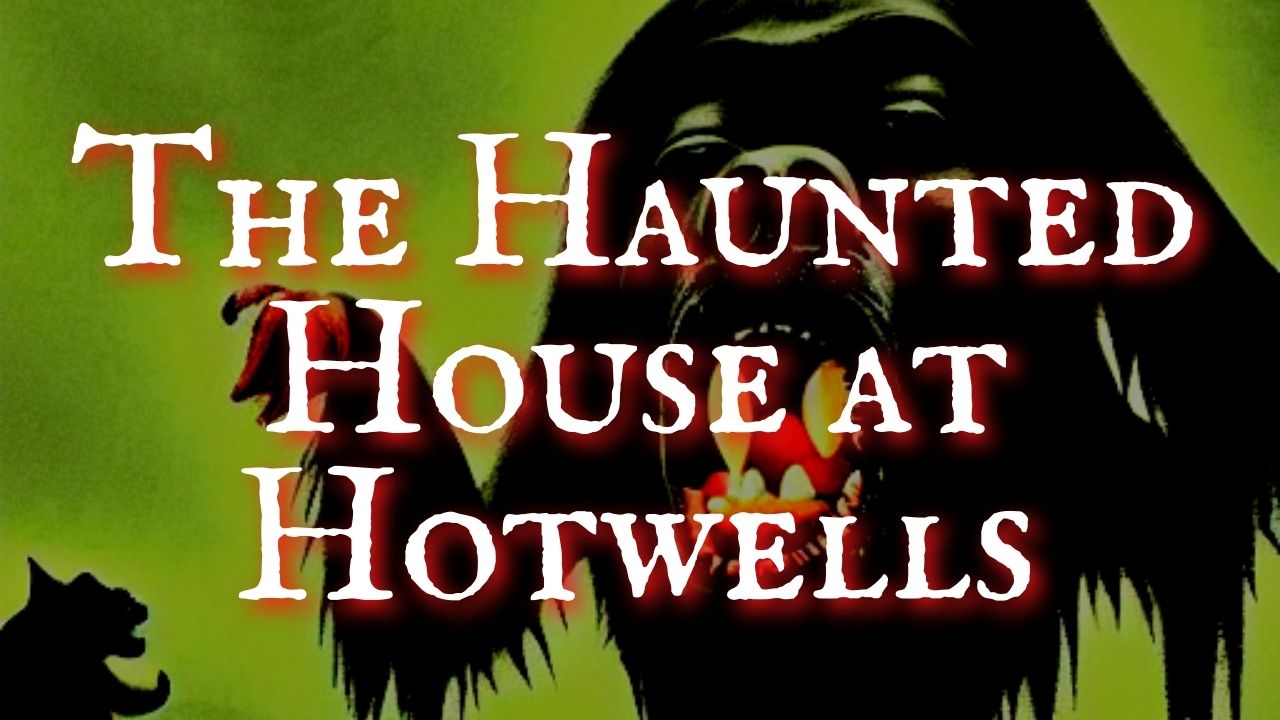The Hotwells Haunting at Bristol

The Haunted House of Hotwells
From Glimpses In The Twilight by Reverend Frederick Lee 1844
My father purchased the freehold of a small and comfortable house, called “Hotwells,” with two acres of land, near Bristol, about the year 1829.
It stood quite alone— away from the village, but not far from the village church; and there he intended to settle, having quitted his old house in London, and given up his profession (the legal).
He bought the place quite a bargain. It had been dilapidated, but the owner had covenanted to put it into repair, on condition of recovering a fair amount for the absolute free hold. This was paid, and everything settled, in the spring of 1831. My father, with my youngest sister, a man servant, and two maid-servants, went to reside there in April; when, within a fortnight, both the female servants gave notice to leave.
The house, they maintained, was haunted by two animals—a large ape and a huge black dog. One or the other of those creatures appeared in several of the rooms, and was constantly passing them in the passages and on the stairs; while the strange noises—which were heard elsewhere—alarmed them greatly. In an empty attic, the most frightful sounds were heard, as of people being strangled; and sometimes noises and shouts, as of twenty or thirty persons being beaten severely, came from the courtyard. When they went to investigate the cause of such noises, nothing was seen, nothing heard.
The yard was then as still and silent as the grave, and no explanation of the mystery was forthcoming. On several nights some of the villagers were induced to keep watch ; but they would do so only with lights and lanterns, and in a considerable company. On these occasions the noises then were only heard in the attics ; but, about midnight, the apparitions of the ape and black dog appeared in the courtyard, and were seen by five persons at once. They seemed to. come up through a closed grating from a large cellar underneath an outhouse, and to rush out into the darkness beyond the gates of the enclosure. At least a dozen times these apparitions were seen by the tenants and the villagers, though my father and the man-servant (who had both heard strange enough noises) had never seen any thing.
Early in November 1831, however, when he had changed servants two or three times, he was awaked in the middle of the night by a frightful scream, which came, or seemed to come, from the roof of the house ; and noises simultaneously reached him which seemed as if twenty or thirty chattering work men were removing the tiles, and flinging them down as fast as possible into the garden below. He hastily got up, assumed part of his clothes and dressing-gown, and, summoning the man-servant, went down with him to the front-door, armed with a brace of loaded pistols and a blunderbuss.
They expected to find thieves, or a body of lunatics, or Chartist rioters on an errand of destruction. But on opening the door and making examination, not a soul was to be seen—not a sound heard. None of the tiles had been removed; while the garden was perfectly still and deserted. Similar occurrences, differing somewhat in detail, took place again and again. My father, who was a most unimaginative and prosaic man, came to the distinct conclusion that the house was haunted—as certainly seems to have been the case—and got rid of it to a retired Bristol tradesman in 1832. He in turn, I am told, found his life unbearable there, was unable to dispose of it, and so turned it into three cottages. But even the cottagers—having similar experiences—refused to live there : the spot got a bad reputation; the windows of the untenanted place were broken; the premises in due course went to ruin, and in a few years were pulled down.
Two details of interest should be added : first, that common Report had long and deliberately maintained that a series of murders had been committed in the house in the early part of the present century, about 1807, and that a noted “gentleman highwayman [i]” who, with certain accomplices, had plied his trade on the old Bath and Exeter road, was supposed to have been the murderer ; and secondly, that so recently as the year 1869, “a huge black dog, with a monster riding on its back,” was seen from time to time by several persons in the field on which the old mansion-house of Hotwells once stood, as reported in the Bristol newspapers of the time.[ii]
[i] He was known as “ Gentleman Jack,” and believed to have been a member of a noble family in Cornwall. He died in bed, but in despair, without the consolations of religion, and eventually a dangerous maniac.
[ii] Amongst these, cited before Squire Harford, were John W. Jackson, Charles Higham, Robert Brownson, Henry Gill, Richard Fox, William Colehurst, James Hampton, Harry Hampton, and Benjamin Byles, whose affidavit to that effect I have seen.
The English Ghost by Peter Ackroyd
I got this story from Peter Ackroyd’s book The English Ghost: Spectres through time.
Acrkoyd reproduces the report from Rev. Frederick Lee’s book verbatim, but leaves off the postcript beginning “Two details of interest should be added…”
I notice he did that with the Are The Renishaw Hall Ghosts True, or Simply Made Up by Its Colorful Master? story too. I don’t know why as it adds interesting detail to the story which otherwise is inexplicable.
Of course, nearly all ‘real’ apparitions are inexplicable and chaotic in that they don’t seem to have any meaning. Perhaps that’s why he didn’t include Lee’s postscript about the Cornish gentleman highwayman who apparently took victims back to the house and murdered them.
The reports of the huge black dog with a monster riding on its back which were seen as late as 1869 (three decades after Wayland Senior had left the house). We wonder if the monster on its back was an ape.
You can read hear me talking about Black Dogs on this blog’s companion YoutTube Channel: Haunted Places.
Backround to the Hotwells Haunting
We see on Google Maps that Hotwells is a district of Bristol, located to the south of and below the high ground of Clifton, directly north of the floating harbour. The southern entrance to the Avon Gorge lies at the western end of Hotwells.
It gets its name from the hot springs that bubble up through the rocks of the Avon Gorge underneath the Clifton Suspension Bridge. The springs were first documented in 1480 by WIlliam Worcester.The wells were used as a ‘cure’ and by the 1630s was known for its medicinal properties. In 1773, a review of Hotwells Water, known as ‘Bristol Water’ found it very pleasant and said it came up at a constant 76 F. It became extensively bottled in the 18th Century, and was a drunk by Admiral Horatio Nelson, and Alexander Pope, among others.
The area drew in many tourists for this purpose up until the Napoleonic Wars when it went into decline and by 1816 did not have much custom any more. Hotwells is very built up now. Much of the area was originally salt marsh known as Rownham Mead, but this area was excavated in the early 1800s. The old pump house for the water was demolished in 1867 to allow for the widening of the River Avon.The area became a bit of a slum in the 20th Century.
The church may have been the Grade II listed Church of the Holy Trinity, built in 1829. The Church was destroyed by German bombing in the Second World War but has since been rebuilt.
Wayland Senior purchased a house at Hotwells in 1829 and left in 1832, so itit would have been being built. I’m not sure if there was a previous parish church, but one presumes it would have been on the same site. At that time the house he’d bought stood alone, outside the village, but not too distant from the village church. Wayland’s father had been a lawyer in London but had come to Hotwells to retire.
The house had been delapidated, but Wayland’s father moved in in April 1831 after it had been put in order. He had with him James Wayland’s youngest sister, a man-servant and two maid-servants.
I can’t find a James Wayland on Ancestry, but I find a James Walland married at Bath on 30 December 1834 at St James’s Church. Otherwise it’s difficult to trace these men.
Within two weeks the female servants gave notice to leave due to the house being haunted by a large ape and a huge black dog. These creatures would appear in several rooms and on the stairs and passages. There was also an empty attic and from this top room dreadful noises were heard, as if someone was being strangled, noises and shouts, and from outside in the courtyard the sounds of twenty or thirty people being beaten. Nothing was seen.It appears that Mr Wayland senior got the villagers to stand watch and several of them saw the black dog and the ape in the courtyard by torchlight. They seemed to come up through the grating from the large cellar into the courtyard.
In November 1831, Mr Wayland senior, who had changed servants many times, was wakened by a scream that seemed to come from the roof and then he heard the sounds as if there were lots of people on the roof, hurling down his tiles. He put on his dressing gown and armed with a blunderbuss went to investigate with the manservant with him. When they got out of the house it was perfectly still and there was no sign of any tiles being disturbed. Wayland describes his father as unimaginative, but these events kept happening to him.
Eventually, in 1832, he sold the house to a Bristol business owner, and the rumour was that this man in his turn found living at the house unbearable due to the terrible commotions from the haunting.Eventually the house could get no tenant and was pulled down.
Is Hotwells a Paranormal Hotspot?
The internet is a wonderful place for finding things and getting lost. I searched for further paranormal events at Hotwells. For indeed an ape riding a monster black dog surely would garner attention in later years and surely it can’t just have left?
I found the Hotwells Crocodile. There is even a crocodile warning road sign there now after a jogger saw a crocodile in the River Avon at Hotwells in the early 2000s and the local school has a crocodile mural on its wall because of this, but moving back to ghosts…
Then I found the Bag o’ Nails pub (originally from Bacchanaals…) where there are fourteen? cats you are encouraged to stroke. But back to ghosts…
I can find lots of references to Hotwells House which was erected in 1696 after the site was leased by the Society of Merchant Venturers and it was used for taking the waters, that we’ve mentioned before. I do not think this is the haunted house.
There is a book called Letters from the Mountains, published in 1809 by an anonymous lady. She writes lots of letters and some of them are from when she was lodging at Hotwells House in 1802, which she finds very pleasant. Again, I think this is the place referred to above, not the haunted house. That house, we know is knocked down, but it would be nice to find where it stood.
Interestingly in another book, there is a reference to 9 April, 1700 where a committee was set up to look into the practice of people flocking to Hotwells on the pretence of taking the waters, but in fact spending their time supping and swilling in the ale houses.
Here’s a history of Hotwells. I quote
Starting with Dowry Square, elegant Georgian terraces had spread across the green slopes of Clifton. There were two assembly rooms. There were hotels, lodging houses and taverns. Down below there was a colonnade of shops beside Hotwell House, which included a circulating library. The New Vauxhall Gardens offered riverside walks. Since only the wealthy could afford to patronise spas, there was money to be made in catering to their comforts and pleasures.
In its heyday Hotwells was crowded with the nobility and gentry. There was a ball, a public breakfast and a promenade every week, and often twice a week. The Pump Room was packed and the walk to it thronged with fashionable company.
Society at the Hotwells enjoyed picnics, river trips and rides or walks on the Downs. The romantic scenery had a huge appeal in an age which admired the picturesque. The heroine of Fanny Burney’s Evelina visits the Hotwell:
a most delightful spot; the prospect is beautiful, the air pure, and the weather very favourable to invalids.The Hotwells, like Georgian Bath, became a playground for the elite. As the Hotwells was a summer spa and Bath was not, they coexisted happily.War with France halted the development of Clifton in 1793, and by the time peace came, spas were giving way to seaside resorts as fashionable retreats. The Hotwell House was demolished in 1822 to make way for a road. Although a new Pump Room was built with suite of a baths, the spa never regained its former popularity. The spring was eventually sacrificed to improved river navigation. Clifton became a leafy and elegant suburb of Bristol.
The Paranormal Database has records of Bristol hauntings, including one in York Place, Hotwells. This haunting dates from the late 1970s when two people heard a woman’s voice singing a lullaby and the sound of hobnail boots coming to the front door and a key being turned in the lock.
This slight reference is all I can find, but it is interesting because York Place, has some Grade II listed buildings. When we read the reference we see that they are east of Hotwells just below Brandon Hill which is still a wooded park area with Cabot Tower on its top. These houses were built in the early 1800s and have pan-tiled roofs. Even though our haunted house was knocked down, it may have been a similar type and date. These are a terrace, of course while our haunted house stood alone, away from the village (of Hotwells) but closer to the church.
Maps from 1884, show terraced houses like the ones that are listed above, but also single mansions standing in their own grounds. These are more in the Clifton
The earliest map I can find of the area is from 1852 when the streets were still looking quite built up.
Intuition, that unreliable guide, makes me wonder whether the ape haunted house was east of Hotwells Village, nearer to Brandon Hill and in that case the church referred to might be St Paul’s, which was built in 1790 and fell into disuse in the 1980s, though I now think it is being refurbished.
Got this v. interesting map via Jynxxxycat on Youtube. You see that York Place is prominent (the 1970s haunting) and the church just down. I fancy Hotwells Mansion as one of the houses standing on its own south of the Church.

Conclusion on The Hotwells Haunting
I think that the affluent Mr Wayland with his servants retired to one of the then big houses in what is actually Clifton, just away from Hotwells (probably better known at time Wayland was writing to Rev. Frederick Lee) with his youngest daughter and servants.
The note that it may have been used by a highwayman in 1807. In fact Highwaymen were still ‘as common as crows’ in England up until 1800. See here
The reference to the 1869 sightings refer to the monster being seen in the field where the old Hotwells Mansion House was.
After scratching my head, it will need a Bristolian to tell me where this place was.
I am disappointed that such a riotous and unusual haunting has not continued to manifest itself.
Other Articles You Might Enjoy
Ghosts of The George and Pilgrims Inn, Glastonbury
The True Story of the Cheltenham Poltergeist
Is The Ancient Ram Inn Haunted?
Haunted Hotels to Stay In Nearby
A Word About Affiliates
As an Amazon Associate I earn from qualifying purchases.

